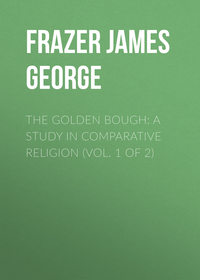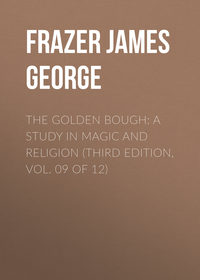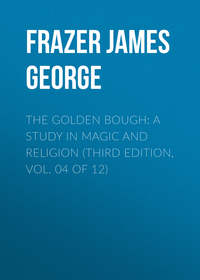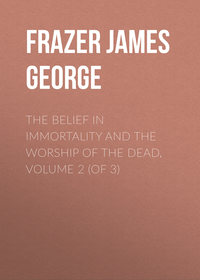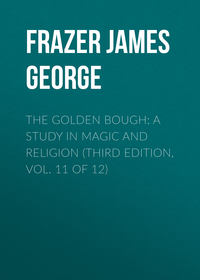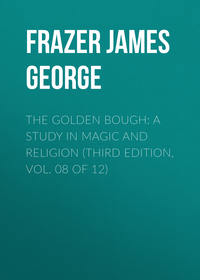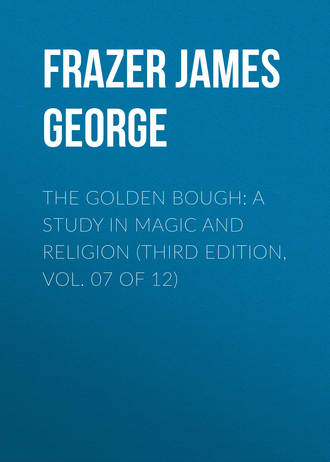
The Golden Bough: A Study in Magic and Religion (Third Edition, Vol. 07 of 12)
952
Ibid. p. 167.
953
E. H. Meyer, Badisches Volksleben (Strasburg, 1900), p. 428.
954
J. Brand, Popular Antiquities, ii. 24, Bohn's edition.
955
C. F. Burne and G. F. Jackson, Shropshire Folk-lore (London, 1883), pp. 373 sq.
956
W. Mannhardt, Mythologische Forschungen, p. 167. We may compare the Scotch custom of giving the last sheaf to a horse or mare to eat. See above, pp. 141, 156, 158, 160 sq., 162.
957
Laisnel de la Salle, Croyances et Légendes du Centre de la France (Paris, 1875), ii. 133; W. Mannhardt, Mythologische Forschungen, pp. 167 sq. We have seen (above, p. 267) that in South Pembrokeshire the man who cut the “Neck” used to be “shod,” that is, to have the soles of his feet severely beaten with sods. Perhaps he was thus treated as representing the corn-spirit in the form of a horse.
958
G. A. Heinrich, Agrarische Sitten und Gebräuche unter den Sachsen Siebenbürgens (Hermannstadt, 1880), p. 21.
959
A. Peter, Völksthumliches aus Österreichisch-Schlesien (Troppau, 1865-1867), ii. 268.
960
J. Lecoeur, Esquisses du Bocage Normand (Condé-sur-Noireau, 1883-1887), ii. 240.
961
A. Wuttke, Der deutsche Volks aberglaube2 (Berlin, 1869), p. 189, § 277; Chr. Schneller, Märchen und Sagen aus Wälschtirol (Innsbruck, 1867), p. 238; Rev. Ch. Swainson, The Folk Lore and Provincial Names of British Birds (London, 1886), p. 173.
962
Alfred Newton, Dictionary of Birds, New Edition (London, 1893-1896), p. 755.
963
A. C. Kruijt, “Eenige ethnografische aanteekeningen omtrent de Toboengkoe en de Tomori,” Mededeelingen van wege het Nederlandsche Zendelinggenootschap, xliv. (1900) pp. 228, 229; id., “De rijstmoeder in den Indischen Archipel,” Verslagen en Mededeelingen van der koninklijke Akademie van Wetenschappen, Afdeeling Letterkunde, Vierde Reeks, v., part 3 (Amsterdam, 1903), pp. 374 sq.
964
W. Mannhardt, Mythologische Forschungen, p. 109 note 2.
965
L. Pineau, Folk-lore du Poitou (Paris, 1892), pp. 500 sq.
966
W. Mannhardt, Mythologische Forschungen, pp. 109 sq., note 2.
967
J. F. L. Woeste, Völksüberlieferungen in der Grafschaft Mark (Iserlohn, 1848), p. 27; W. Mannhardt, Mythologische Forschungen, p. 110 note.
968
Lafcadio Hearn, Glimpses of Unfamiliar Japan (London, 1894), ii. 312 sqq.; W. G. Aston, Shinto (London, 1905), pp. 162 sq. At the festival of the Roman corn-goddess Ceres, celebrated on the nineteenth of April, foxes were allowed to run about with burning torches tied to their tails, and the custom was explained as a punishment inflicted on foxes because a fox had once in this way burned down the crops (Ovid, Fasti, iv. 679 sqq.). Samson is said to have burned the crops of the Philistines in a similar fashion (Judges xv. 4 sq.). Whether the custom and the tradition are connected with the idea of the fox as an embodiment of the corn-spirit is doubtful. Compare W. Mannhardt, Mythologische Forschungen, pp. 108 sq.; W. Warde Fowler, Roman Festivals of the Period of the Republic (London, 1899), pp. 77-79.
969
A. Witzschel, Sagen, Sitten und Gebräuche aus Thüringen (Vienna, 1878), p. 213, § 4. So at Klepzig, in Anhalt (Zeitschrift des Vereins für Volkskunde, vii. (1897) p. 150).
970
J. B. Holzmayer, “Osiliana,” Verhandlungen der gelehrten Estnischen Gesellschaft zu Dorpat, vii. Heft 2 (Dorpat, 1872), p. 107; W. Mannhardt, Mythologische Forschungen, p. 187.
971
A. Birlinger, Aus Schwaben (Wiesbaden, 1874), ii. 328.
972
F. Panzer, Beitrag zur deutschen Mythologie (Munich, 1848-1855), ii. pp. 223, 224, §§ 417, 419.
973
W. Mannhardt, Mythologische Forschungen, p. 112.
974
E. L. Meyer, Badisches Volksleben (Strasburg, 1900), pp. 428, 436.
975
E. Meier, Deutsche Sagen, Sitten und Gebaüche aus Schwaben (Stuttgart, 1852), p. 445, § 162.
976
A. Birlinger, Volksthümliches aus Schwaben (Freiburg im Breisgau, 1861-1862), ii. p. 425, § 379.
977
F. Panzer, Beitrag zur deutschen Mythologie, ii. pp. 221-224, §§ 409, 410, 411, 412, 413, 414, 415, 418.
978
W. Mannhardt, Mythologische Forschungen, pp. 186 sq.
979
Above, p. 272; compare 268.
980
Above, p. 298.
981
W. Mannhardt, op. cit. p. 187.
982
W. Mannhardt, op. cit. pp. 187 sq.; A. Witzschel, Sagen, Sitten und Gebräuche aus Thüringen, pp. 189, 218; W. Kolbe, Hessische Volks-Sitten und Gebräuche (Marburg, 1888), p. 35.
983
W. Mannhardt, Mythologische Forschungen, p. 188; W. R. S. Ralston, Songs of the Russian People (London, 1872), p. 220.
984
W. Mannhardt, Antike Wald- und Feldkulte, pp. 197 sq.; F. Panzer, Beitrag zur deutschen Mythologie, ii. 491; J. Jamieson, Etymological Dictionary of the Scottish Language, New Edition (Paisley, 1879-1882), vol. iii. pp. 206 sq., s. v. “Maiden”; Arv. Aug. Afzelius, Volkssagen und Volkslieder aus Schwedens älterer und neuerer Zeit, übersetzt von F. H. Ungewitter (Leipsic, 1842), i. 9.
985
Above, p. 275.
986
L. Lloyd, Peasant Life in Sweden (London, 1870), pp. 169 sq., 182. On Christmas night children sleep on a bed of the Yule straw (ibid. p. 177).
987
U. Jahn, Die deutschen Opfergebräuche (Breslau, 1884), p. 215. Compare The Magic Art and the Evolution of Kings, ii. 17, 27 sq.
988
A. A. Afzelius, op. cit. i. 31.
989
A. A. Afzelius, op. cit. i. 9; L. Lloyd, Peasant Life in Sweden, pp. 181, 185.
990
J. B. Holzmayer, “Osiliana,” Verhandlungen der gelehrten Estnischen Gesellschaft zu Dorpat, vii. Heft 2 (Dorpat, 1872), pp. 55 sq.
991
F. J. Wiedemann, Aus dem inneren und äussern Leben der Ehsten (St. Petersburg, 1876), pp. 344, 485.
992
Above, pp. 277 sq., 280, 281, 285, 290, 300, 301. In regard to the hare, the substitution of brandy for hare's blood is probably modern.
993
W. Mannhardt, Die Korndämonen (Berlin, 1868), p. 1.
994
R. Andree, “Die Pleiaden im Mythus und in ihrer Beziehung zum Jahresbeginn und Landbau,” Globus, lxiv. (1893) pp. 362-366.
995
Mr. McKellar, quoted by the Rev. W. Ridley, “Report on Australian Languages and Traditions,” Journal of the Anthropological Institute, ii. (1873) p. 279; id., Kamilaroi (Sydney, 1875), p. 138. Mr. McKellar's evidence was given before a Select Committee of the Legislative Council of Victoria in 1858; from which we may perhaps infer that his statement refers especially to the tribes of Victoria or at all events of south-eastern Australia. It seems to be a common belief among the aborigines of central and south-eastern Australia that the Pleiades are women who once lived on earth but afterwards went up into the sky. See W. E. Stanbridge, in Transactions of the Ethnological Society of London, N.S. i. (1861) p. 302; P. Beveridge, “Of the Aborigines inhabiting the great Lacustrine and Riverine Depression of the Lower Murray,” etc., Journal and Proceedings of the Royal Society of New South Wales, xvii. (Sydney, 1884) p. 61; Baldwin Spencer and F. J. Gillen, Native Tribes of Central Australia (London, 1899), p. 566; id., Northern Tribes of Central Australia (London, 1904), p. 628; A. W. Howitt, Native Tribes of South-East Australia (London, 1904), pp. 429 sq. Some tribes of Victoria believed that the Pleiades were originally a queen and six of her attendants, but that the Crow (Waa) fell in love with the queen and ran away with her, and that since then the Pleiades have been only six in number. See James Dawson, Australian Aborigines (Melbourne, Sydney, and Adelaide, 1881), p. 100.
996
J. Manning, “Notes on the Aborigines of New Holland,” Journal and Proceedings of the Royal Society of New South Wales, xvi. (Sydney, 1883) p. 168.
997
James Dawson, Australian Aborigines, p. 75.
998
M. Dobrizhoffer, Historia de Abiponibus (Vienna, 1784), ii. 118.
999
M. Dobrizhoffer, op. cit. ii. 77 sq., 101-105.
1000
Pedro de Angelis, Coleccion de Obras y Documentes relativos a la Historia antigua y moderna de las Provincias del Rio de la Plata (Buenos Ayres, 1836-1837), iv. 15.
1001
P. Lozano, Descripcion chorographico del terreno, rios, arboles, y animales del Gran Chaco (Cordova, 1733). p. 67.
1002
W. Barbrooke Grubb, An Unknown People in an Unknown Land (London, 1911), p. 139.
1003
Pedro de Angelis, op. cit. iv. 14.
1004
Th. Waitz, Anthropologie der Naturvölker, iii. (Leipsic, 1862) p. 418, referring to Marcgrav de Liebstadt, Hist. rerum naturalium Brasil. (Amsterdam, 1648), viii. 5 and 12.
1005
M. Dobrizhoffer, Historia de Abiponibus, ii. 104.
1006
Th. Koch-Grünberg, Zwei Jahre unter den Indianern (Berlin, 1909-1910), ii. 203.
1007
C. F. Phil. v. Martius, Zur Ethnographie Amerika's, zumal Brasiliens (Leipsic, 1867), p. 441.
1008
Carl Teschauer, S.J., “Mythen und alte Volkssagen aus Brasilien,” Anthropos, i. (1906) p. 736.
1009
J. Gumilla, Histoire Naturelle et Civile et Géographique de l'Orenoque (Avignon, 1758), iii. 254 sq.
1010
E. J. Payne, History of the New World called America, i. (Oxford, 1892) p. 492.
1011
P. J. de Arriaga, Extirpacion de la Idolatria del Piru (Lima, 1621), pp. 11, 29 sq. According to Arriaga, the Peruvian name for the Pleiades is Oncoy.
1012
Garcilasso de la Vega, First Part of the Royal Commentaries of the Yncas, translated by (Sir) Clements R. Markham (London, 1869-1871, Hakluyt Society), i. 275. Compare J. de Acosta, Natural and Moral History of the Indies (London, 1880, Hakluyt Society), ii. 304.
1013
E. Seler, Alt-Mexikanische Studien, ii. (Berlin, 1899) pp. 166 sq., referring to Petrus Martyr, De nuper sub D. Carolo repertis insulis (Basileae, 1521), p. 15.
1014
B. de Sahagun, Histoire Générale des choses de la Nouvelle Espagne (Paris, 1880), pp. 288 sq., 489 sqq.; A. de Herrera, General History of the Vast Continent and Islands of America, translated by Capt. J. Stevens (London, 1725-1726), iii. 222; F. S. Clavigero, History of Mexico, translated by C. Cullen (London, 1807), i. 315 sq.; J. G. Müller, Geschichte der amerikanischen Urreligionen (Bâle, 1867), pp. 519 sq.; H. H. Bancroft, The Native Races of the Pacific States of North America (London, 1875-1876), iii. 393-395.
1015
Jean l'Heureux, “Ethnological Notes on the Astronomical Customs and Religious Ideas of the Chokitapia or Blackfeet Indians,” Journal of the Anthropological Institute, xv. (1886) pp. 301-303.
1016
Walter McClintock, The Old North Trail (London, 1910), p. 490.
1017
J. Walter Fewkes, “The Tusayan New Fire Ceremony,” Proceedings of the Boston Society of Natural History, xxvi. (1895) p. 453.
1018
Rev. W. Ellis, Polynesian Researches, Second Edition (London, 1832-1836), i. 87.
1019
Rev. W. W. Gill, Myths and Songs from the South Pacific (London, 1876), p. 43.
1020
Rev. W. W. Gill, op. cit. p. 317, compare p. 44.
1021
G. Turner, Samoa (London, 1884), p. 279.
1022
E. Shortland, Traditions and Superstitions of the New Zealanders, Second Edition (London, 1856), p. 219.
1023
The United States Exploring Expedition, Ethnography and Philology, by Horatio Hale (Philadelphia, 1846), p. 170; E. Tregear, Maori-Polynesian Comparative Dictionary (Wellington, N.Z., 1891), p. 226.
1024
Rev. R. H. Codrington, The Melanesians (Oxford, 1891), p. 348. In the island of Florida the Pleiades are called togo ni samu, “the company of maidens” (op. cit. p. 349).
1025
H. B. Guppy, The Solomon Islands and their Natives (London, 1887), p. 56.
1026
A. C. Haddon, “Legends from Torres Straits,” Folk-lore, i. (1890) p. 195. We may conjecture that the “new yam time” means the time for planting yams.
1027
R. Neuhauss, Deutsch Neu-Guinea (Berlin, 1911), pp. 159, 431 sq.
1028
A. F. van Spreeuwenberg, “Een blik op de Minahassa,” Tijdschrift voor Neerlands Indië, Vierde Deel (Batavia, 1845), p. 316; J. G. F. Riedel, “De landschappen Holontalo, Limoeto, Bone, Boalemo, en Kattinggola, of Andagile,” Tijdschrift voor Indische Taal- Land- en Volkenkunde, xix. (1869) p. 140; id., in Zeitschrift für Ethnologie, iii. (1871) p. 404.
1029
Spenser St. John, Life in the Forests of the Far East, Second Edition (London, 1863), i. 214. Compare H. Low, Sarawak (London, 1848), p. 251.
1030
Dr. Charles Hose, “Various Modes of computing the Time for Planting among the Races of Borneo,” Journal of the Straits Branch of the Royal Asiatic Society, No. 42 (Singapore, 1905), pp. 1 sq. Compare Charles Brooke, Ten Years in Sarawak (London, 1866), i. 59; Rev. J. Perham, “Sea Dyak Religion,” Journal of the Straits Branch of the Royal Asiatic Society, No. 10 (Singapore, 1883), p. 229.
1031
Dr. Charles Hose, op. cit. p. 4. Compare id., “The Natives of Borneo,” Journal of the Anthropological Institute, xxiii. (1894) pp. 168 sq., where the writer tells us that the Kayans and many other races in Borneo sow the rice when the Pleiades appear just above the horizon at daybreak, though the Kayans more usually determine the time for sowing by observation of the sun. As to the Kayan mode of determining the time for sowing by the length of shadow cast by an upright pole, see also W. Kükenthal, Forschungsreise in den Molukken und in Borneo (Frankfort, 1896), pp. 292 sq. Some Dyaks employ a species of sun-dial for dating the twelve months of the year. See H. E. D. Engelhaard, “Aanteekeningen betreffende de Kindjin Dajaks in het Landschap Baloengan,” Tijdschrift voor Indische Taal- Land- en Volkenkunde, xxxix. (1897) pp. 484-486.
1032
A. W. Nieuwenhuis, Quer durch Borneo (Leyden, 1904-1907), i. 160.
1033
F. K. Ginzel, Handbuch der mathematischen und technischen Chronologie, i. (Leipsic, 1906) p. 424.
1034
R. Friederich, “Voorloopig Verslag van het eiland Bali,” Verhandelingen van het Bataviaasch Genootschap van Kunsten en Wetenschappen, xxiii. (1849) p. 49.
1035
J. T. Nieuwenhuisen en H. C. B. von Rosenberg, “Verslag omtrent het eiland Nias en deszelfs Bewoners,” Verhandelingen van het Bataviaasch Genootschap van Kunsten en Wetenschappen, xxx. (Batavia, 1863) p. 119.
1036
W. Marsden, History of Sumatra, Third Edition (London, 1811), p. 71.
1037
F. K. Ginzel, Handbuch der mathematischen und technischen Chronologie, i. (Leipsic, 1906) p. 428.
1038
S. Krascheninnikow, Beschreibung des Landes Kamtschatka (Lemgo, 1766), p. 217. The three stars are probably the Belt.
1039
See above, vol. i. p. 116.
1040
Rev. J. Macdonald, Light in Africa, Second Edition (London, 1890), pp. 194 sq. Compare J. Sechefo, “The Twelve Lunar Months among the Basuto,” Anthropos, iv. (1909) p. 931.
1041
G. McCall Theal, Records of South-Eastern Africa, vii. (1901) p. 418. Compare G. Thompson, Travels and Adventures in Southern Africa (London, 1827), ii. 359.
1042
Rev. H. Callaway, The Religious System of the Amazulu, Part iii. (London, etc., 1870), p. 397.
1043
R. Moffat, Missionary Labours and Scenes in Southern Africa (London, 1842), pp. 337 sq.
1044
Stephen Kay, Travels and Researches in Caffraria (London, 1833), p. 273.
1045
Gustav Fritsch, Die Eingeborenen Süd-Afrika's (Breslau, 1872). p. 340.
1046
Theophilus Hahn, Tsuni-Goam, the Supreme Being of the Khoi-Khoi (London, 1881), p. 43, quoting the Moravian missionary George Schmidt, who was sent out to the Cape of Good Hope in 1737.
1047
H. S. Stannus, “Notes on some Tribes of British Central Africa,” Journal of the R. Anthropological Institute, xl. (1910) p. 289.
1048
M. Merker, Die Masai (Berlin, 1894), pp. 155, 198.
1049
May.
1050
June-August.
1051
A. C. Hollis, The Masai (Oxford, 1905), p. 275, compare p. 333. The “season of showers” seems to be a name for the dry season (June, July, August), when rain falls only occasionally; it is thus distinguished from the rainy season of winter, which begins after the reappearance of the Pleiades in September.
1052
A. C. Hollis, The Masai, pp. 275 sq.
1053
A. C. Hollis, The Nandi (Oxford, 1909), p. 100.
1054
C. W. Hobley, “Further Researches into Kikuyu and Kamba Religious Beliefs and Customs,” Journal of the Royal Anthropological Institute, xli. (1911) p. 442.
1055
Thomas Winterbottom, An Account of the Native Africans in the Neighbourhood of Sierra Leone (London, 1803), p. 48.
1056
Hesiod, Works and Days, 383 sq., 615 sqq. See above, pp. 45, 48.
1057
Aratus, Phaenomena, 264-267; Pliny, Nat. Hist. ii. 123, 125, xviii. 280, “Vergiliae privatim attinent ad fructus, ut quarum exortu aestas incipiat, occasu hiems, semenstri spatio intra se messes vindemiasque et omnium maturitatem conplexae.” Compare L. Ideler, Handbuch der mathematischen und technischen Chronologie (Berlin, 1825-1826), i. 241 sq. Pliny dated the rising of the Pleiades on the 10th of May and their setting on the 11th of November (Nat. Hist. ii. 123, 125).
1058
Pliny, Nat. Hist. xviii. 49 and 223.
1059
See above, p. 307.
1060
Geminus, Elementa Astronomiae, xvii. 10 sqq. If “the sweet influences of the Pleiades” in the Authorised Version of the English Bible were an exact translation of the corresponding Hebrew words in Job xxxviii. 31, we should naturally explain the “sweet influences” by the belief that the autumnal setting of the constellation is the cause of rain. But the rendering of the words is doubtful; it is not even certain that the constellation referred to is the Pleiades. See the commentaries of A. B. Davidson and Professor A. S. Peak on the passage. The Revised English Version translates the words in question “the cluster of the Pleiades.” Compare H. Grimme, Das israelitische Pfingstfest und der Plejadenkult (Paderborn, 1907), pp. 61 sqq.


